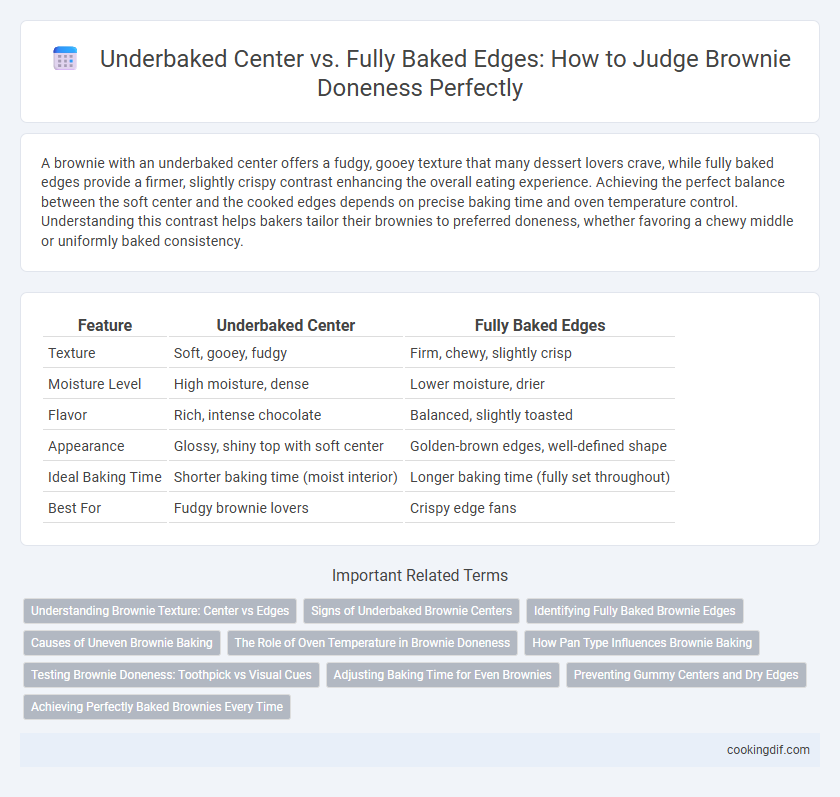A brownie with an underbaked center offers a fudgy, gooey texture that many dessert lovers crave, while fully baked edges provide a firmer, slightly crispy contrast enhancing the overall eating experience. Achieving the perfect balance between the soft center and the cooked edges depends on precise baking time and oven temperature control. Understanding this contrast helps bakers tailor their brownies to preferred doneness, whether favoring a chewy middle or uniformly baked consistency.
Table of Comparison
| Feature | Underbaked Center | Fully Baked Edges |
|---|---|---|
| Texture | Soft, gooey, fudgy | Firm, chewy, slightly crisp |
| Moisture Level | High moisture, dense | Lower moisture, drier |
| Flavor | Rich, intense chocolate | Balanced, slightly toasted |
| Appearance | Glossy, shiny top with soft center | Golden-brown edges, well-defined shape |
| Ideal Baking Time | Shorter baking time (moist interior) | Longer baking time (fully set throughout) |
| Best For | Fudgy brownie lovers | Crispy edge fans |
Understanding Brownie Texture: Center vs Edges
The underbaked center of a brownie typically exhibits a gooey, fudgy texture due to retained moisture and less heat exposure, creating a dense and rich bite. In contrast, the fully baked edges are firmer and slightly crispier, as prolonged oven heat causes more moisture evaporation and caramelization of sugars. Recognizing this textural difference helps in achieving the ideal balance of soft center and chewy edges for a perfect brownie experience.
Signs of Underbaked Brownie Centers
Signs of underbaked brownie centers include a glossy, wet appearance and a softer, almost gooey texture that resists clean cutting. When inserting a toothpick, it typically comes out with moist crumbs rather than clean or dry, indicating incomplete cooking. The center may also appear slightly puffed and more fragile compared to the firm, chewy edges, signaling underbaking.
Identifying Fully Baked Brownie Edges
Fully baked brownie edges are characterized by a firm texture and a slightly crisp surface that holds its shape when lifted from the pan. These edges often pull away from the sides of the baking dish, creating a subtle gap that signals doneness. In contrast to the softer, fudgy center, fully baked edges provide a pleasant contrast in texture, ensuring an even bake throughout the brownie.
Causes of Uneven Brownie Baking
Uneven brownie baking often results from variations in oven temperature and pan placement, causing the edges to cook faster than the center. Factors such as using a dark metal pan or placing the pan too close to the oven walls can increase heat conduction at the edges, leading to a fully baked crust and an underbaked, gooey center. Insufficient mixing of batter or uneven batter thickness also contributes to inconsistent doneness in brownies.
The Role of Oven Temperature in Brownie Doneness
Oven temperature plays a crucial role in achieving the perfect brownie doneness, as higher temperatures can cause the edges to cook faster and become fully baked while leaving the center underbaked and gooey. Maintaining a consistent medium heat, typically around 325degF to 350degF, allows even cooking throughout, preventing overly crisp edges and ensuring the center is set without being raw. Variations in oven temperature can create uneven texture, where the edges develop a firm crust while the middle remains soft, highlighting the importance of precise heat control for ideal brownie consistency.
How Pan Type Influences Brownie Baking
Using a metal pan for brownies promotes even heat distribution, resulting in firm, fully baked edges and a slightly underbaked center for a fudgy texture. Glass pans retain heat longer, often causing edges to bake faster and become thicker or crispier while the center remains softer and gooier. Silicone pans provide gentle and consistent heat, which can minimize the contrast between the edges and the center, leading to a more uniform doneness throughout the brownie.
Testing Brownie Doneness: Toothpick vs Visual Cues
Testing brownie doneness often involves using a toothpick inserted into the center; if it comes out with moist crumbs but not wet batter, the underbaked center is typically achieved. Fully baked edges are indicated by a firm, slightly pulling-away crust, signaling completion without overcooking. Visual cues like glossy crackled tops combined with toothpick results help balance fudgy texture and avoid dryness.
Adjusting Baking Time for Even Brownies
Adjusting baking time is crucial for achieving even brownies with a perfectly set center and fully baked edges. Shortening the time results in an underbaked center with gooey texture, while extending baking time ensures firm edges but risks dryness. Using an oven thermometer and rotating the pan midway promotes uniform heat distribution for consistent doneness throughout the brownie.
Preventing Gummy Centers and Dry Edges
Achieving the perfect brownie requires balancing the underbaked center and fully baked edges to prevent gummy centers and dry edges. Using an oven thermometer ensures accurate temperature control, while adjusting baking time and pan size promotes even heat distribution. Incorporating ingredients like eggs and melted butter with the right ratios enhances moisture retention, yielding a fudgy center without sacrificing the edges' texture.
Achieving Perfectly Baked Brownies Every Time
Achieving perfectly baked brownies every time requires balancing the underbaked center and fully baked edges to maintain optimal texture. The center should remain slightly gooey, indicating retained moisture and fudginess, while the edges develop a firm, chewy crust for contrast. Monitoring internal temperature around 195degF and using toothpick tests focused on the center helps ensure consistent doneness without overbaking the edges.
Underbaked Center vs Fully Baked Edges for Brownie Doneness Infographic

 cookingdif.com
cookingdif.com